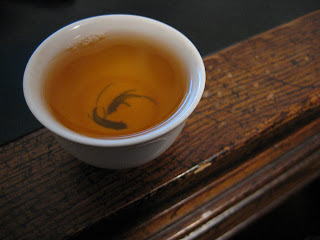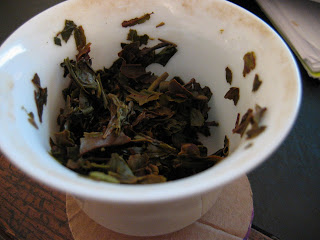This one is really catching my interest. I sourced this chunk of a sample from Puerhshop.

Messing around with the chunk... it's really buddy, just as the title suggests. It's much less dense than the usual puerh. It bends, and flakes apart easily with only the hands. Pretty fun to break up, to tell you the truth. I pretty much broke this up to the point of it being loose. Because of this, I'll only do one quick rinse, and I won't expect too many infusions.
Leaf in the preheated gaiwan gives off a fragrance of dead grass, fairly earthy. The brewed soup is very light amber in color. Smell is slightly honey and hay. Taste is actually very pleasant for a young sheng. A sweet structure, tasting of honey, some floralness, a muted hay, and perhaps some hidden cantaloupe. No astringency whatsoever.
 Sip
Sip. That taste was amazing. I've never had a puerh anything like that. I feel like this is a significant tea. The taste is giving me something that I would have expected from a "white puerh." This is a pleasant break-away from the usual profile of young sheng.
The wet leaf, however, does not smell good. Like hay and animals.

2nd infusion is slightly darker in color. This infusion tastes slightly more like hay when it's at its hottest, subsiding as the temperature drops. The taste then slows to a floral concoction, similar to a green oolong, yet with notes of hay bringing it back to the sheng side. I think this tea should definitely be drunk at slightly lower temperatures. The aftertaste is pronounced and enduring, mellow and sweet, similar to potato chips.
3rd infusion and the smell of the wet leaf is reminding a lot of the berry-notes of white tea. Exactly what it is. The hay in this infusion has now hit the same taste that I find characteristic of white tea; a berry-like smoothness accompanied by a hay-earthiness. This tea is very individual. If you're expecting a young sheng, you're going to be surprised. If you expect what you read in this review, you're going to be dead-on.
This definitely tastes better warm(warm-hot), rather than hot. The deeper flavors come out, and the high notes of hay become blended and muted.
20 second fourth steep added a hint of astringency. If this isn't a white puerh, I expect it to be very simlar. Doesn't taste like a 2005 sheng either. Perhaps more like a 2002 or older mellow puerh.
 This picture is of the first infusion. Following infusions actually came out a bit darker, oranger. Unfortunately I was feeling the vibe of the session and forgot to take more pictures.
This picture is of the first infusion. Following infusions actually came out a bit darker, oranger. Unfortunately I was feeling the vibe of the session and forgot to take more pictures.
5th infusion stays kicking with all the flavors mellowed out. I did forget the filter for this one, although this tea hardly needs to be filtered.
6th infusion. Looking through the leaves in the gaiwan, this isn't just "mostly" tips. It's all tips. Minus a couple very young leaves. This tea didn't give out early, I'm surprised. I thought the less leaf, and fully broken apart nature of the leaf would lead this puerh to infuse quickly. However, this sixth steep is not even pronouncing signs of backing down. Perhaps only just, this one is a bit lighter in flavor, but not lacking in it. I find it more enjoyable now, to be honest. Mellow, light, and extremely enjoyable. This tea compliments the end to a warm spring day quite nicely. In fact, I've never tasted such a good decline in a tea.
I seem to have developed a nice, relaxed state of calm. Listening to "Underworld - Dark Train," and enjoying the development and decline of a puerh throughout the steepings. Truly something to be cherished in life.
7th steep. What's interesting, is that unlike white tea, all these buds sink and stay at the bottom. Again, I tried a 30 second steep, and was awarded with a hint of astringency. This tea doesn't need the longer time yet. 10 seconds would have sufficed. Still, this longer steep has brought back the earthy berry-nature that reminds me strongly of white tea.
8th steep is running down in flavor. I am surprised it lasted this long without a smathering of leaf. Overall, I'm very happy with this tea, and I recommend anyone who's looking for something a little different in sheng to grab up a sample.
I actually just threw in a 9th infusion. Gears still moving. I'm surprised it can last this long. One of the favorable characteristics of a good puerh.



































